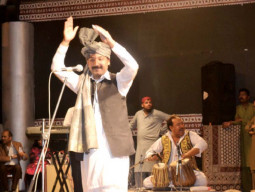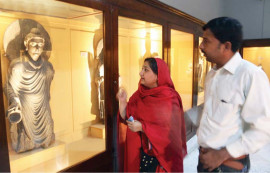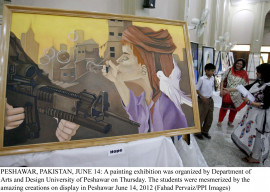
As forms of art and expression, pottery and sculpture have existed within the settlements of Swat Valley for centuries. Back in the day when Buddhists ruled the region, pottery remained closely-knit with ritualism and was practiced under state patronage.
Until recently, over 150 families of potters lived in Mingora and its outskirts. The past few years haven’t been the most encouraging for the lot. Many abandoned the trade for good, escaping persecution during the years of militancy, while others switched permanently to creating utensils items for daily use.

Ali Rahmat, a potter from Sangota in Swat, owns a modest shop at the foot of the hills along the road in the area. The bare bricks of the walls speak of his state of affairs. Inside the shop, makeshift shelves support the weight of Rahmat’s creations. Some of the larger earthenware is scattered outside the shop and also placed carefully on its roof – the only form of advertisement Rahmat can afford. Talking to The Express Tribune, he said what started off as a pastime soon became his primary source of income. “The skill was passed on to my father from his forefathers,” he said. He further enhanced his expertise in Taxila, Punjab.
Read: Pottery: Ceramics workshop concludes
Recalling troubled times, Rahmat said one day militants stormed his shop and destroyed all his inventory. “They threatened to put a bullet in my head if I do not shun the practice,” he said, adding that was the day he padlocked the shop and fled to Sahiwal. “Those were tough times, mind you, but I refined my skills in those years. I returned to Swat in 2010.”

Some of the earthenware is scattered outside the shop and also placed on its roof – the only form of advertisement Rahmat can afford. PHOTOS: MUHAMMAD IRFAN/EXPRESS
Today Rahmat’s store has a wide variety of earthenware on offer. From jugs to cups, clay lamps to toys – you will find everything under one roof. “One cannot make a fortune from selling clay moulds, but it is enough for me to make ends meet,” he said. Over the years he expanded from selling utensils to taking orders of busts and lifelike figures from Punjab. “It takes a lot of hard work. I create everything from scratch all by myself. Some of these models are priced at thousands of rupees,” he said, adding he prefers to keep them in his workshop. “Those are obviously not for sale.”
Read: Lok Mela 2015: Festival showcases dying crafts from all over country
While Rahmat was showing his shop, a customer walked in. He produced Rs3,000 from his pocket and placed an order of three figurines. Talking to The Express Tribune, customer Khayam Hassan said he studies literature and plans on sending the sculptures over to his teacher in the United Kingdom as gifts.
The impressionist
As Rahmat caters to his customers down country, his cousin – Ghwari Masta’s Zahir Shah – is another artisan whose creations are quite popular amongst those who visit the valley. Over the years, Shah has mastered the art of creating small utensils and impressions of Athenian vases. His workshop is laden with tea sets, jars, horses, mud nests and countless decorative containers. While clay has been a lifelong companion, Shah is friends with acrylics too. His inventory is a kaleidoscope of natural hues. Tourists buy his creations as souvenirs and this is how Shah manages to keep the stove burning. Shah admitted the artist within him has somewhat surrendered to his monetary needs. “We now create only to sell,” he said, adding the link road ahead remains busy the year round and quite a number of visitors en route from Kalam and other areas pull over every day.

Some of the earthenware is scattered outside the shop and also placed on its roof – the only form of advertisement Rahmat can afford. PHOTOS: MUHAMMAD IRFAN/EXPRESS
He disagreed with the notion that things have always been the same for the potters. “Back in the 90s you could see foreigners roaming around in the area freely. They would acquire our creations solely for their aesthetic value and worry little about the money,” he said. “Usually I am able to take home Rs2,000 every day. On a good day I can make as much as Rs5,000.” Shah said the district government is not even aware that the area’s pottery industry is on the verge of extinction.
Published in The Express Tribune, July 8th, 2015.






































COMMENTS
Comments are moderated and generally will be posted if they are on-topic and not abusive.
For more information, please see our Comments FAQ